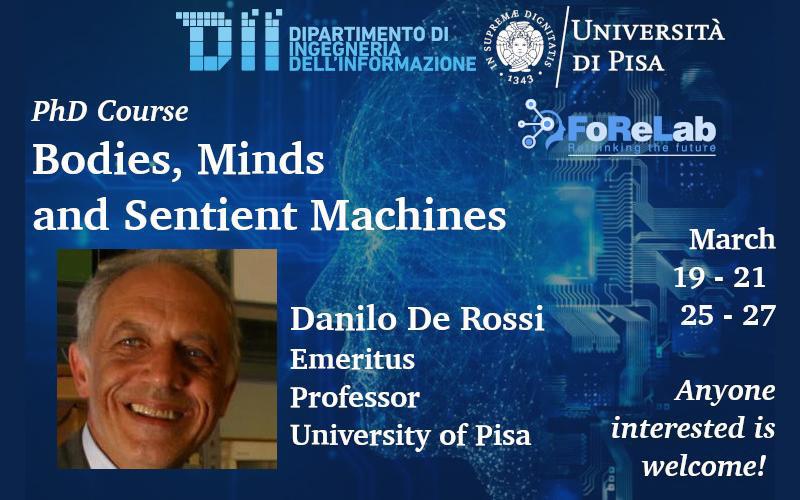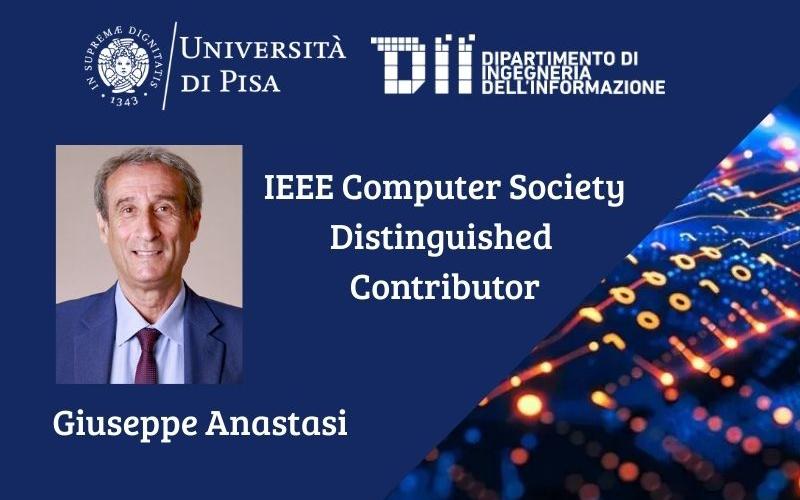La nomina a Distinguished Contributor (DC) premia i membri e gli affiliati della Computer Society che hanno apportato contributi tecnici significativi e continuativi alla IEEE Computer Society, alla...
Leggi tuttoBodies, Minds and Sentient Machines

Doctoral Course. Open to everyone interested
Danilo De Rossi, University of Pisa
dderossi11@gmail.com
20 hours (5 credits)
Room: Aula Riunioni del Dipartimento di Ingegneria dell’Informazione, Via G. Caruso 16, Pisa - Ground Floor
To register to the course, click here
Danilo De Rossi received the “Laurea” degree in Chemical Engineering from the University of Genoa in 1976. From 1976 to 1981 he was researcher of the Institute of Clinical Physiology of C.N.R. He had appointments for teaching and research in Australia, Brasil, France, Japan and USA. He joined the school of Engineering at the University of Pisa in 1982, and from 1994 was Full Professor of Bioengineering where he was coordinating of the Bioengineering Group at the Research Centre “E. Piaggio”. His scientific activities are related to the physics of organic and polymeric materials, and to the design of sensors and actuators for bioengineering and robotics. He received the “Bioengineering Forum Award” of the Biological Engineering Society (UK) in 1980, and the “Young Investigator Award” of the American Society for Artificial Organs (USA) in 1985. He received the
Order of the Cherubino in 2012 and is Professor Emeritus at the University of Pisa since 2021. He is author of over 300 peer reviewed papers on international science journals and peer reviewed proceedings, co-inventor of 14 patents and co-author of 8 books.
Short Abstract:
This short course has three aims:
- Providing a critical-historical account of long enduring effort to develop humanized machines.
- Providing insight from large multidisciplinary stance of theories and implementations
- Describing the author’s own effort to develop a sentient humanoid
Course Contents in brief:
1) HISTORIES OF AUTOMATA ( OPTIONAL )
From Hero to Voucanson
From Wiener to Walters
From Ashby to McCarthy
From McCarthy to Brooks
2) The rise of Humanoids
Androids, gynoids and cyborg
Just like a human? The Uncanny Valley controversy
Internal robotics and machine monism
3) Robotics meets neuroscience
Cognitive neuroscience and the rise of affectivism
Affect and emotions
Edelman neural darwinism
Damasio theory of consciousness
Craig on interoception and inner time
4) Robotics meets phenomenology
Time of physics and subjective time: Einstein and Bergson
From Husserl to Varela
The embodied mind and the neurophenomenology program
Emotions, feelings and the self
A syncretic model of time-consciousness
5) Towards sentient robots
A situated,embodied ,enactive machine
Body awareness and the protoself
Time-consciousness and the minimal self : core cosciousness
The autobiografical self and the extended consciousness
6) Do we need conscious robots? Ethics and societal needs
Schedule:
- 19/3/2023 - 9:00-12:00
- 20/3/2023 - 9:00-12:00
- 21/3/2023 - 9:00-13:00
- 25/3/2023 - 9:00-12:00
- 26/3/2023 - 9:00-13:00
- 27/3/2023 - 9:00-12:00
Final Exam:
The student will be asked to the develop a project on the topics of the course. The title and the project objective will be identified with the support of the teacher. The project will be presented in written form within 1 month by the end of the course.
References:
[1] Cohen, J. (1967) Human Robots in Myth and Science, A. S. Barnes
[2] Brooks, R. A. (2002) Robot: The Future of Flesh and Machines, Allen Lane, The Penguin Press
[3] Barrett, L. F. (2017). How Emotions Are Made: The Secret Life of the Brain. Stati Uniti: Houghton Mifflin Harcourt.
[4] Mensch, J. R. (2023). Husserl’s Phenomenology: From Pure Logic to Embodiment. Germania: Springer Nature Switzerland.
[5] Varela, F. J., Thompson, E., Rosch, E. (2017). The Embodied Mind, Revised Edition: Cognitive Science and Human Experience. Stati Uniti: MIT Press.
[6] Damasio, A. R. (1999). The Feeling of what Happens: Body and Emotion in the Making of Consciousness. Regno Unito: Harcourt Brace.
[7] Craig, A. D. (2020). How Do You Feel? An Interoceptive Moment with Your Neurobiological Self. Stati Uniti: Princeton University Press.
[8] Adams B., Breazeal C., Brooks R.A., Scassellati B. Humanoid robots: A new kind of tool (2000) IEEE Intelligent Systems and Their Applications, 15 (4), pp. 25 – 30
[9] Scassellati B. Theory of mind for a humanoid robot (2002) Autonomous Robots, 12 (1), pp. 13 – 24
[10] Cominelli L., Mazzei D., De Rossi D.E. SEAI: Social emotional artificial intelligence based on Damasio's theory of mind (2018) Frontiers Robotics AI, 5 (FEB), art. no. 6
[11] Dreyfus H.L. Why Heideggerian AI failed and how fixing it would require making it more Heideggerian (2007) Artificial Intelligence, 171 (18), pp. 1137 – 1160
[12] Seth A.K., Bayne T. Theories of consciousness (2022) Nature Reviews Neuroscience, 23 (7), pp. 439 – 452
[13] Dainton, Barry, "Temporal Consciousness", The Stanford Encyclopedia of Philosophy (Spring 2023 Edition), Edward N. Zalta & Uri Nodelman (eds.), URL = <https://plato.stanford.edu/archives/spr2023/entries/consciousness-tempor....
[14] Kent L., Van Doorn G., Klein B. Systema Temporis: A time-based dimensional framework for consciousness and cognition (2019) Consciousness and Cognition, 73, art. no. 102766
[15] Gallagher S. The past, present and future of time-consciousness: From Husserl to Varela and beyond (2017) Constructivist Foundations, 13 (1), pp. 91 - 97



